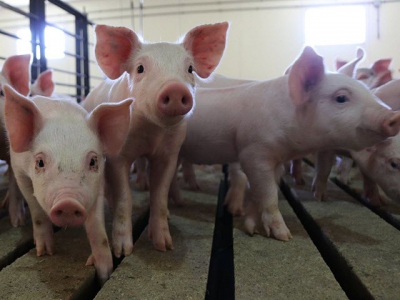Researchers address challenges in livestock pain mitigation

Progress is being made as a research protocol is being established to reliably evaluate efficacy of pain mitigation interventions in nursing male piglets during castration.
A pig or a cow can't tell someone when it's injured or in pain, but researchers are identifying ways to measure not only when an animal is in pain, but also what measures can be taken to help alleviate that pain. Abbie Viscardi, a research assistant professor in the anatomy and physiology department at Kansas State University, focuses primarily on validating non-invasive tools for pain assessment and pain alleviation of food animals on-farm to improve animal welfare. She shared her work at the 2019 U.S. Animal Health Association annual meeting, held last week in Providence, R.I.
Pain is defined as an "unpleasant sensory and emotional experience associated with actual or potential tissue damage, or described in terms of such damage." Viscardi's emphasis is on the sensory experience of pain, which results in changes to an animal's behavior and physiology. The emotional experience of pain is difficult to measure with present technology.
Sources of pain for animals can include castration, tail docking, dehorning/disbudding or branding. Pain can also be associated with production or natural interaction between animals, including lameness, abrasion, the process of giving birth or infectious diseases.
A number of factors create challenges in terms of pain management for farm animals.
- Pain is difficult to recognize and some animals have instinctive mechanisms that inhibit their ability to exhibit pain
- Time delay between drug administration and onset of activity would slow down processing procedures or lead to inadequate analgesia at the time of a painful procedure
- Drug administration (routes and frequency) can be difficult on-farm
- Cost of drugs can be prohibitive
- Meat and milk withholding periods are often necessary
- Only one analgesic is approved for use by the Food and Drug Administration in the United States to alleviate pain
The last factor is particularly important because at the present time, just one analgesic is approved for pain, and it is labeled to address pain associated with foot rot in cattle. The FDA states, "We [FDA] recommend that this indication be based on the control of clinical signs of pain associated with a disease. We encourage the use of validated methods of pain assessment in the target species." In other words, the FDA wants researchers to determine effective ways to assess pain before it will recommend products to deal with it.
"Obviously, animals can't self-report so we look at assessment tools," Viscardi says. These include behavior, facial grimace analysis, plasma cortisol, infrared thermography, algometery (pressure tolerance at the surgical site) and pressure-mat analysis, among others.
Products are being tested for their efficacy and potential use for pain mitigation. In addition, there is the possibility that pain can be eliminated through immune-castration and genetic selection (sexed semen).
"We can look at behaviors associated with a painful event," Viscardi says. "We can measure activity levels and monitor how often they're eating. It's as simple as setting a camera up and observing behavior but it's also labor intensive and can be subjective."
Some studies have shown pain management options in livestock are effective, but others have been inconclusive. Viscardi says it's difficult to give a recommendation to producers or veterinarians when researchers aren't in agreement on whether or not a drug is effective.
Progress is being made, however. The Pain Mitigation Assessment Protocol Working Group is working to establish a research protocol to reliably evaluate efficacy of pain mitigation interventions in nursing male piglets during castration. This partnership with FDA, the National Pork Board and the American Association of Swine Veterinarians is a good first step to finding viable solutions for pain mitigation.
The USAHA covers topics ranging from zoonotic diseases, to regulations, to specific diseases in cattle, horses, sheep, cervids, poultry and pigs, and much more. Leaders from government, industry and academia gather alongside producers to find solutions to health issues that can help animal agriculture thrive.
Có thể bạn quan tâm
 Early detection key to controlling ASF spread
Early detection key to controlling ASF spread EFSA projects very high chance of ASF spreading among southeastern European countries but very low chance of spreading to other EU member states.
 Are growing pigs the missing piece in PRRS control?
Are growing pigs the missing piece in PRRS control? About 50% of wean-to-finish sites tested positive with wild type PRRS virus in the 10-month Midwest field study.
 Nursery enrichment objects may enhance weanling pig welfare
Nursery enrichment objects may enhance weanling pig welfare Prairie Swine Center releases annual report of research results from past year.